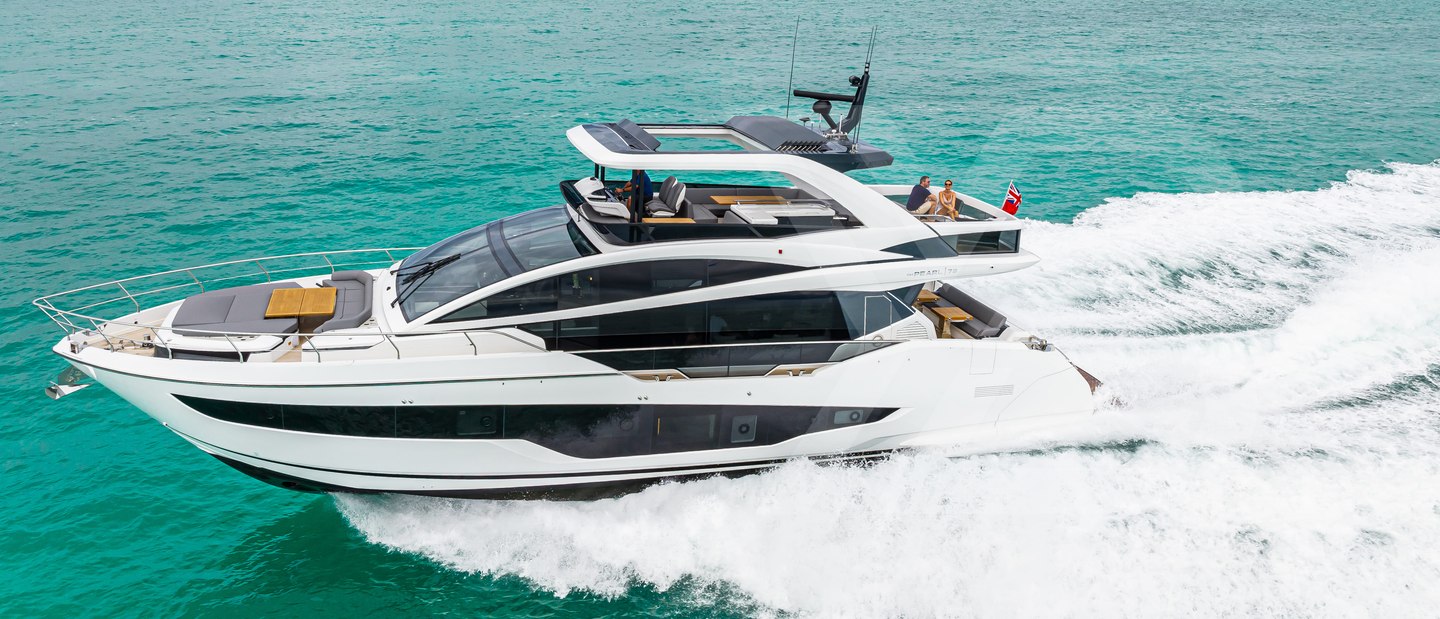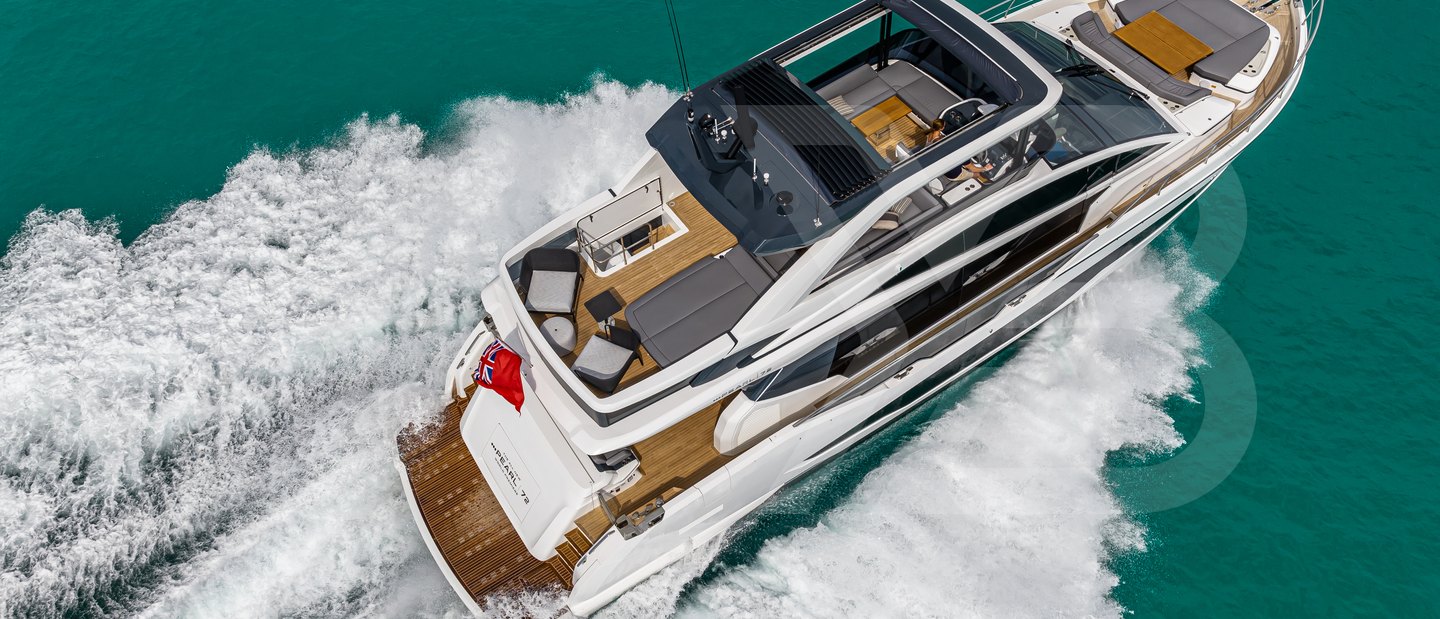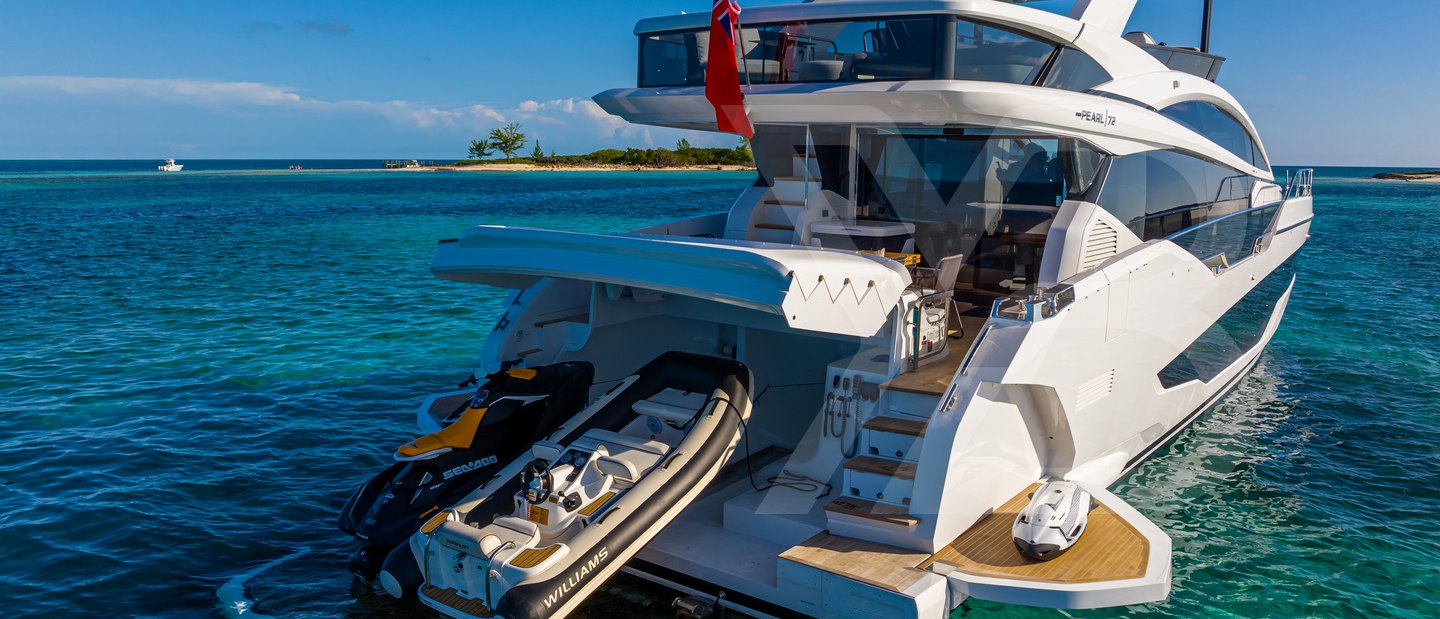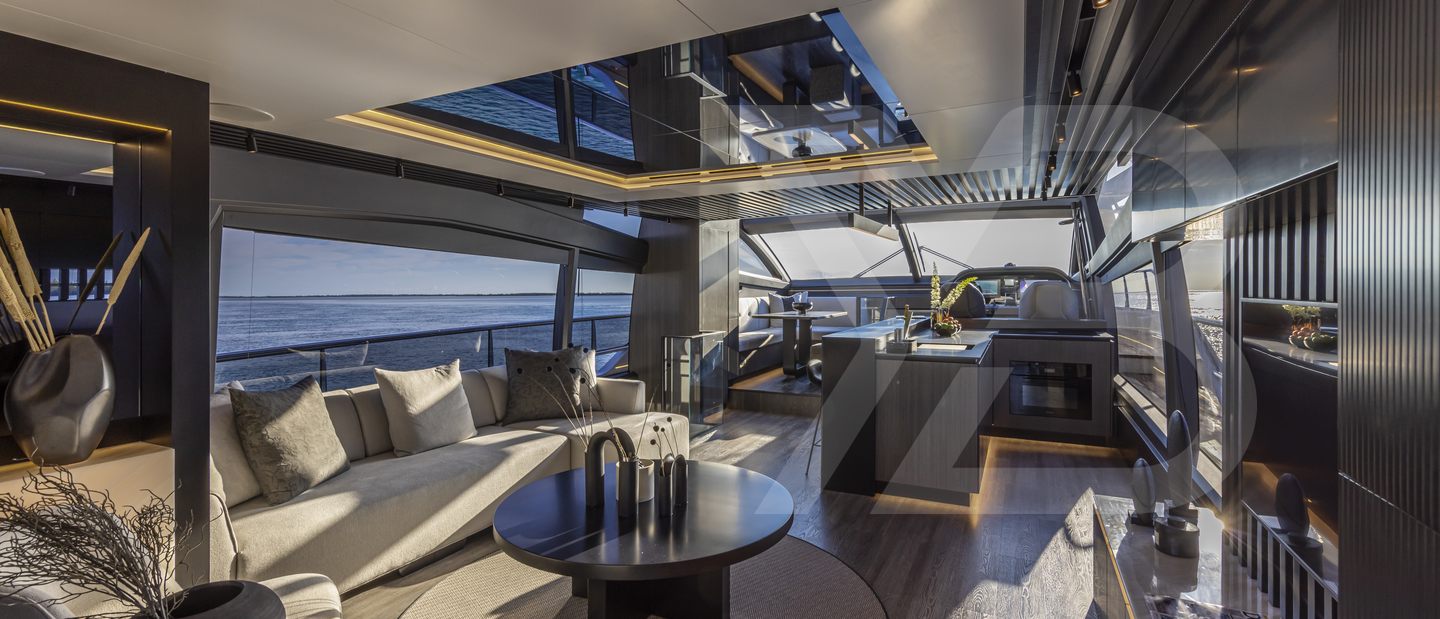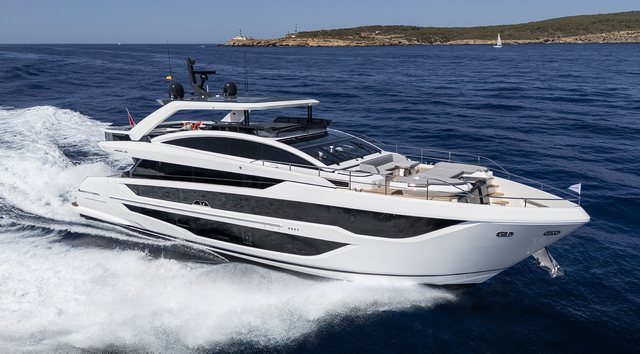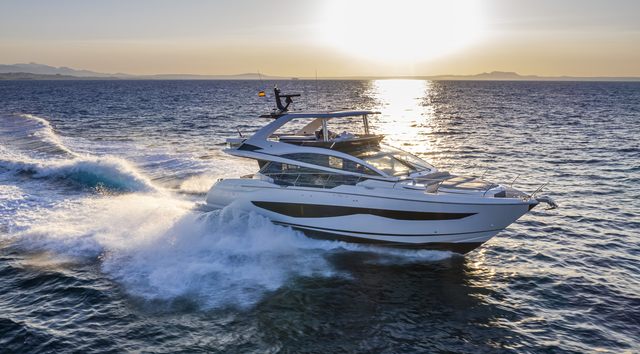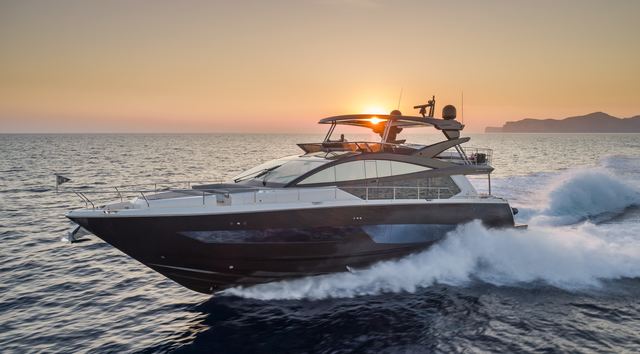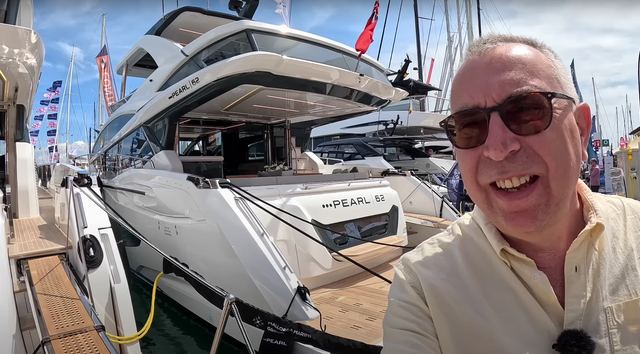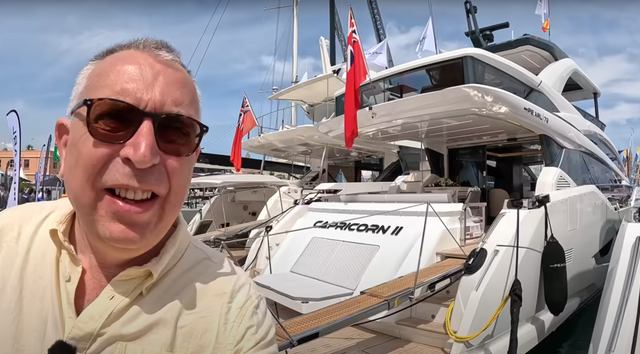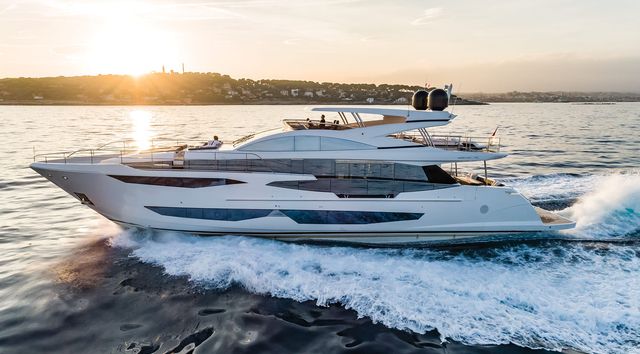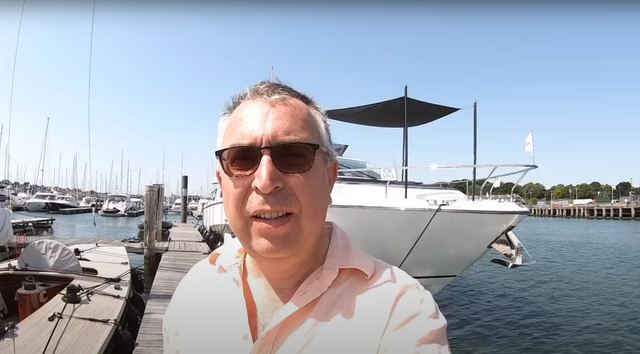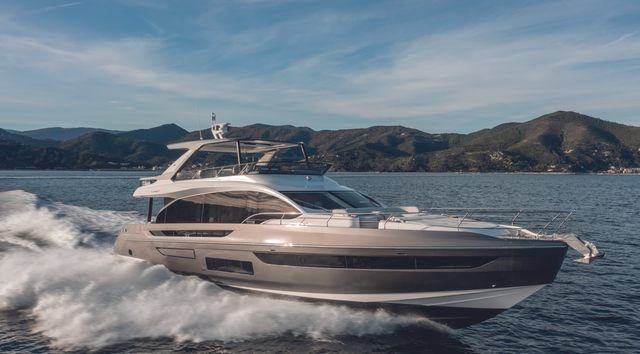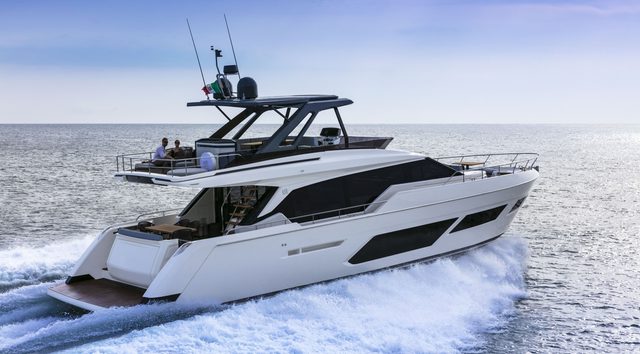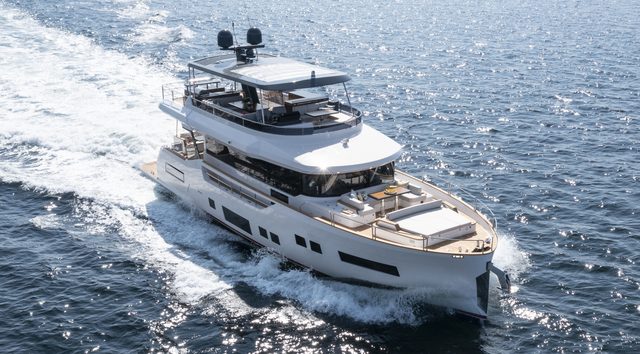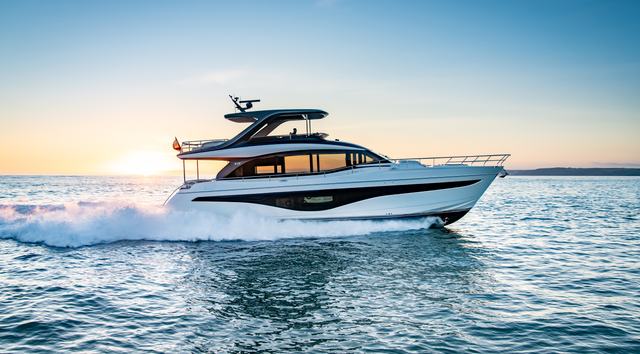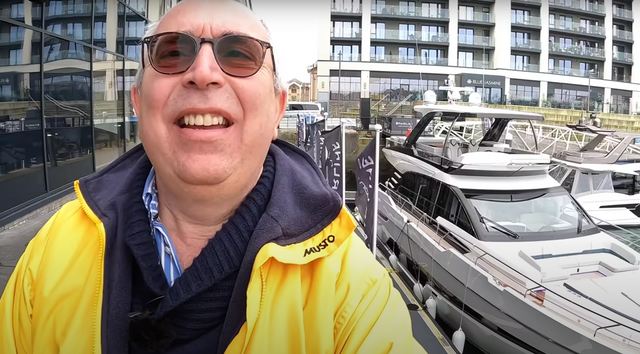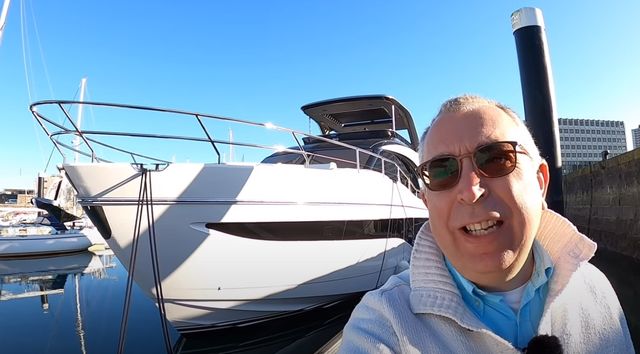The Bill Dixon/Kelly Hoppen partnership returns with Pearl's all-new 72. It's a four-stateroom design with what Pearl describes as two owner's suites - one right forward in the bow with private access and the other in its traditional amidships location.
The other part of this complex lower deck puzzle is the inclusion of a tender garage with space for a tender, jet-ski, and Seabob and a two-person crew space. Engine options are from MAN and MTU, the 1,600hp MTUs good for 32 knots flat out and a 250nm cruising range at 25 knots. Tongues were wagging after the 72 was unveiled at the 2022 Fort Lauderdale Boat Show but does the 72 live up to expectations? Read on to find out.
Test & Review Video
Around the Marina
Those meaty MTUs may provide awesome power out at sea but their low-speed grunt also makes negotiating marinas pretty straightforward. An Aventics joystick is an option that our test boat didn't have but the tactile ZF throttles snick in and out of gear with ease and the boat responds with a positive shove in either direction. Around the marina you can leave the wheel alone and just manoeuvre the boat on the throttles, such is the level of shove from the propellers.
Our test boat was fitted with the standard thrusters but it's well worth upgrading to the (£13,920) hydraulic bow and stern thrusters which provide proportional thrust, won't fade under heavy load, and have a hold mode to pin the boat against the dock.
You can't see the bathing platform from either helm but a suite of cameras provide a view of all sides of the boat via the MFDs. If stern-to-mooring is going to be the norm then shelling out £7,230 for the third docking station in the cockpit is well worth it. Here you get engine start/stop, another pair of throttles, and bow and stern thruster controls so you can handle the boat from within the cockpit. It's not only in the Med where this position can be useful, but the berth we had on the test day also was tight and I felt most comfortable helming from the cockpit to give me the best sight lines aft and it worked brilliantly.
The joystick is a £23,870 option but, if you're used to handling a boat with throttles and thrusters, it's an outlay that can be avoided given how docile the 72 is at slow speed.
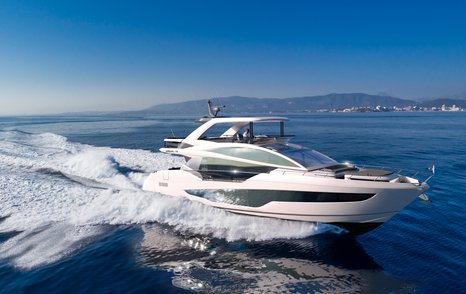


At Sea
At 2,000rpm and around 80% engine load the 72 is in its stride. The big MTUs feel like they're hardly working but this 50-tonne flybridge is purring along at 25 knots for a range of 247nm (with 10% in reserve). The performance is effortless up to a top speed of 33 knots, which is up there with the best-performing boats in this class. The MTUs are a GBP £54,100 upgrade over the standard 1,400hp MAN V8s, which is no small change, but they suit the boat well and are proven to be reliable.
With a 4,340-litre fuel tank that is integrated into the hull, the 72's capacity is a little down on its rivals so its slow-speed range isn't quite as good as the Princess Y72 or Azimut 72. Still, at 10 knots you'll get around 600nm out of it, and even at top speed, you're looking at well over 200nm with a 10% reserve.
This may have been a quirk of our test boat, which was hull number one and still had some small issues to be addressed, but the MTUs were quite noisy at idle. Up at speed, they melted away to a perfectly respectable level, even when driving from the lower helm, but they were notably throaty in and out of gear.
Conditions were kind during our test in the Solent so the only real challenge the hull faced was crossing our own wash, which the 72 did with consummate ease. As the tide pushed around The Needles a bit of swell kicked up but there was nothing to wrong foot Bill Dixon's solid feeling hull.
Mounting the engines further back in the boat on V-drives is what allows the extraordinary use of space on board but even with the 4.5-tonne engine weight distributed further back in the boat the 72's running attitude stays level at speed. No doubt the Humphree active interceptors, which work constantly to adjust the boat's trim according to speed and conditions, have a hand in this but the boat's natural balance feels on the money.
The steering isn't quite as engaging as the Princess Y72's, which is the best handling boat in the class, but it's very good for such a big, heavy craft. The 72 tracks neatly on passage but if you do need to hand steer it's quick to respond to the helm and has a healthy amount of heel. The turning circle is pretty neat, too. It's a very enjoyable boat to drive at speed and has greater agility and more poise than you might expect of a boat of this type.
Pearl's partnership with British designer Bill Dixon continues with the 72 and the shipyard ensured he had his work cut out with this brief. The desire to incorporate two master cabins (as Pearl describes them) and a garage large enough to carry a jet-ski, tender, and Seabob side-by-side was made clear from the off so the packaging of this 21.99m (72ft) yacht had to be as tight as a drum.
Dixon has risen to the challenge and managed to include two double staterooms with a further double and a twin plus the requisite tender space without any of these areas feeling compromised. The crew accommodation suffers slightly compared to some rivals but given many of these yachts will be owner-run that is a trade-off that most will accept.
To include all of this and still keep the proportions in check is an absolute triumph. The latest generation of Pearls are really good-looking boats, characterised by the slashes of glazing that tear through the topsides and superstructure. The 72 is modern yet elegant and retains the typical Pearl styling cues such as the slender elliptical windows in the saloon and the extended windscreen which draws a huge amount of light into the boat's interior.



Inside Line
Interior designer Kelly Hoppen has been working with Pearl for years and her style lends the Pearl range a unique look and feel. For the 72 she developed a new theme dubbed 'Indulgence', which has a darker more masculine palette and offers a refreshing contrast to the walnuts and oaks that we see elsewhere in the market. It won't be for everyone and it's a GBP £30,000 option, so it was a good call to have the 'Modern' and 'Luxury' themes on the options list for those who want something more traditional.
The 72 uses a hand-laid hull construction and isn't built using vacuum infusion like the majority of its rivals. It's a sold-feeling boat out on the water and the quality of the engineering appears to be very good indeed. The engine room is slightly compromised by the presence of the tender garage molding but it's still a very easy space to work in, even with the massive MTU 10Vs gobbling up so much room.
Access for day-to-day checks is perfectly good and important components like the generators on either side of the space and the optional Seakeeper 18 gyro stabiliser, which is mounted aft between the engines, are easy to inspect.
If the usual offerings of walnut or oak in various states of gloss don't float your boat then the Pearl 72's 'Indulgence' interior will be a welcome tonic. It feels completely different from pretty much anything else this boat's rivals can muster and is one of the few interiors that offers up the New York loft apartment cliché (sorry Kelly) and actually delivers on it. It doesn't feel like a boat interior, but whether that's a good or bad thing will depend on individual taste.
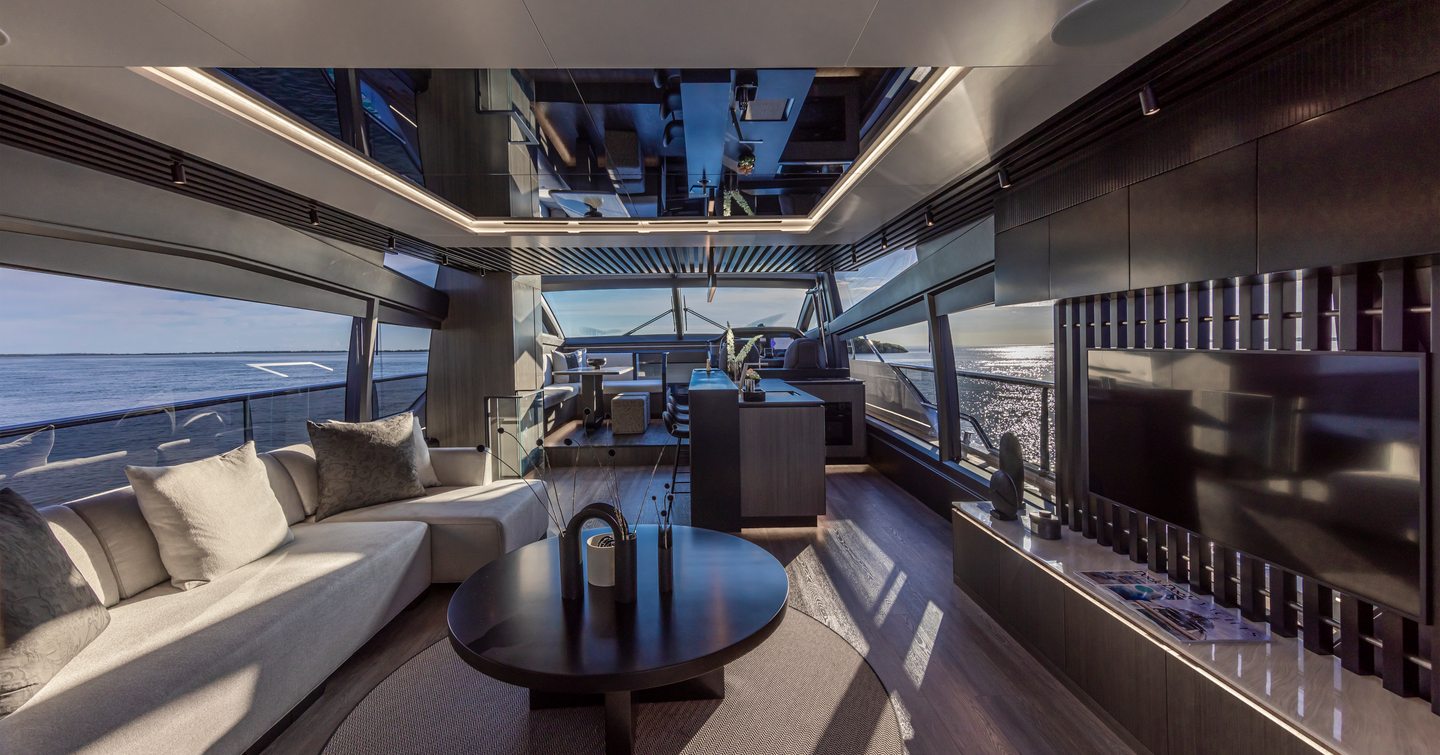
In terms of layout, it shuns the ubiquitous galley-aft arrangement for an amidships location, leaving a stylish lounge area aft that has a fantastic view out of deck-level windows that sit inboard of glass gunwales. There isn't a pop-up television but a fixed one inside an elegant wooden frame that also disguises useful eye-level cupboards and the boat's switch panel.
In fact, most of the practical stuff is neatly disguised, especially in the galley where the dishwasher, cupboards, and fridge/freezer are hidden behind fascias. If you like the modern, clean look then this is the boat for you. The only downside is that the fridge/freezer unit is on the opposite side of the salon to the galley. There are too many sharp corners about the place for my liking, too.
The dinette is forward, opposite, and sits beneath the extended windscreen, a Pearl trademark that deluges the space in natural light. With an interior this dark it makes a huge difference.



Bed Spread
On the lower deck, things get really clever. The guest accommodation is accessed via a dedicated staircase amidships in the salon and it leads to a pair of double cabins and a twin, all of which are ensuite. Amidships is the VIP stateroom (or 'second master' if you're Pearl), a full-beam cabin that stretches across the 72's 5.75m (18ft 10in) beam and gets a generous ensuite to port and a handsome bureau to starboard. It is a lovely space and is separated from the engine room by the crew quarters it should be well insulated from any engine room din, too.
Across the lobby are two further cabins, a decent double with an athwartships bed, ensuite, and bureau, and a twin whose ensuite is also the day head. The lobby area is quite tight but considering the quality of the accommodation here there are very few compromises.


What about the owner? Their cabin has its own access adjacent to the lower helm and it's quite something. The bed is against the aft bulkhead with a breakfast dinette tucked in the point of the bow, flanked by handy cupboard storage. On this boat's rivals, such as the Princess Y72, the owner's cabin is amidships so the ensuite can run behind it making the most of the boat's beam. That's not the case on the Pearl, but even though the ensuite is in the corner of the cabin it's still a good size and, like the rest of this space, dripping with style. The addition of some eye-level windows is a nice touch as well, they bring more light in and provide a view out as you move around the cabin.
The other clever aspect of the configuration of the accommodation is the flexibility of the spaces. For example, if the owner and their family are on board with guests then they can take over the accommodation in the middle of the boat leaving guests to enjoy the privacy of the owner's suite. Alternatively, the owner has a private space forward if they have guests on board with their kids.
The lower helm seats have been raised since I first saw the boat at the Fort Lauderdale Boat Show and they're all the better for it. The seated view for someone of 6ft is good and with the sliding adjustment on the seats and bolster sections it's easy to get comfortable whether you want to sit or stand. The wheel is sited centrally, which means the navigator is trapped in by the skipper, but it also reduces the blind spot created by the starboard windscreen mullion.
It's a well-organized and stylish dashboard with the bulk of information displayed through a pair of flush-mounted Garmin MFDs. There's no criticising MTU's engines but its info screens with their thick plastic surround and chunky buttons look like relics of the 1980s compared to the hardware that other manufacturers are producing these days. It's a brilliantly light area though, thanks to both the extended windscreen and the side door, which is also helpful when it comes to communication and help with crewing.


The layout of the dash upstairs is slightly better than below because everything is angled more toward the helm seats and is easier to read. As with the lower helm, there are two MFDs at the top of the dash and a pair of stylish seats that allow the occupants to adjust their position individually. It's good to see the ZF throttles mounted on a plinth so they fall more easily to hand. Both helms lack device charging; neither has an induction charger or even some USB sockets to charge smartphones or tablets, which is an odd omission these days.
The flybridge helm is on the opposite side of the deck to the companionway hatch so it's hard to see the aft end of the boat from behind the wheel. Thankfully, as well as a suite of cameras that show all sides of the boat, there is a third control station in the cockpit, where it couldn't be easier to keep a close eye on the boat's proximity to the quayside when stern-to-berthing. A joystick that combines the shafts and thrusters is a GBP £22,000 option but for most, the bow and stern thrusters and throttles will offer good enough control at slow speeds, though it's definitely worth upgrading to the proportional thrusters fore and aft.
It's not just inside the boat where the use of space is impressive. The platforms that fold down to water level on either side of the bathing platform are a great example of manufacturing usable space where there wouldn't ordinarily be any. The only thing they're missing is some pop-up cleats so they can be used to tie off water toys and keep them clear of the main platform.
They connect with the main platform, which will always be clear of obstructions because the water toys are stowed inside the tender garage. Drop the platform, flip down the bench built into the garage hatch and, even though it can't reasonably be termed a beach club, you have a great place to relax if people are enjoying the water.
The cockpit features a wrap of seating and a split table system. The two tables remain separate so it's easy to move in and out if guests are lounging or having a drink but, if you want to dine in this area, the tables open up to meet in the middle and create a full-width dining table. There is a bar tucked up against the cockpit doors, too, which is handy given the galley isn't immediately inside the salon.
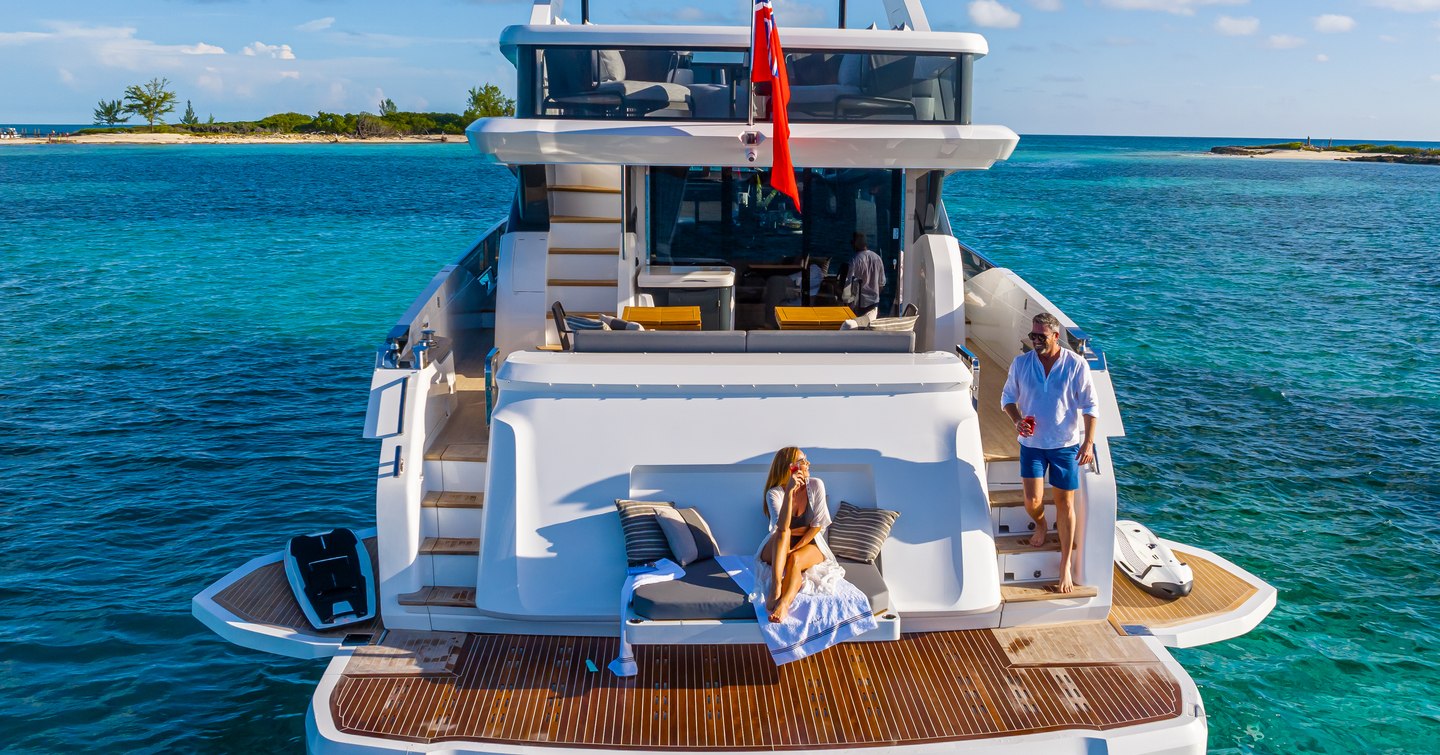


On Deck
The side decks are deep and safe and have built-in side gates on both sides so it's easy to hop on and off at a fuel dock, for example. Instead of LED lights dotted along at deck level, the 72 has an unbroken strip light that runs down both side decks and meets at the bow. It's not something I've seen before but it's a really smart solution and will look fantastic in the dark, no doubt.
The foredeck is well-designed, too. It has the familiar sofa and sun pads setup with a passageway that links the side decks but it has a much larger table than you would normally find and it drops down on telescopic legs to either adjust the height or drop right down to create extra sunbathing space. Elsewhere there are pop-up lights, cup holders, and a pair of really useful lockers on either side of the sofa that are the perfect size to swallow lines and covers.
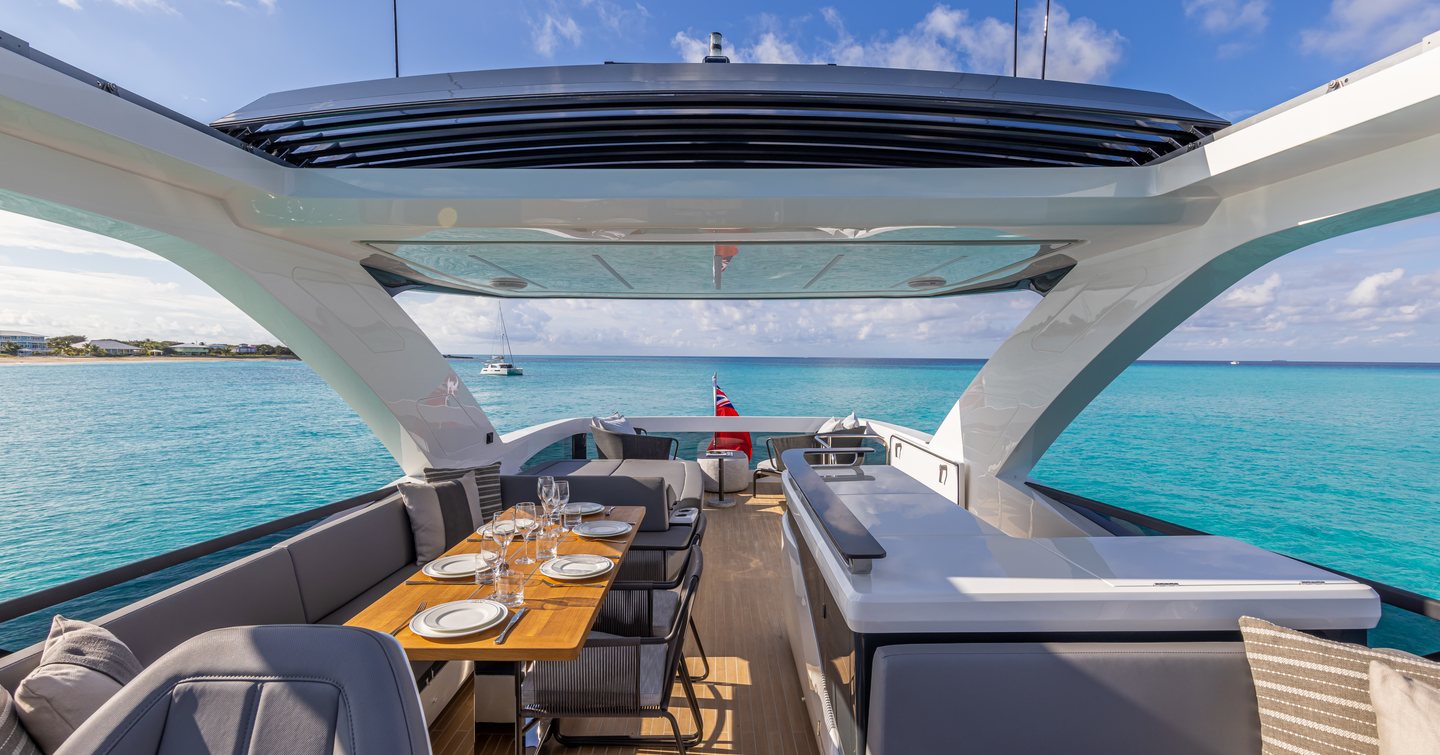
Flying High
The flybridge feels big for a boat this large. It extends a long way back over the cockpit and the neatly integrated hard top adds a sense of security as well as the obvious protection benefits. There is the option to have a fixed hard top, one with a canvas sunroof, or the vane and tilt roof that the test boat had. I don't usually like these slatted roofs but this is the first one I've seen that opens fully as well as tilts and leaves a wind deflector at the forward end. It's a best-of-both-worlds solution but, as a GBP £93,000 option, you certainly pay for the privilege.
Aft there is clear space that can be filled with sleek free-standing furniture to create an appealing sundowner spot, the see-through coaming ensuring there's still a clear view out of the water. The double sun pad butts up to the starboard side of the deck and it can be shaded by a pop-out canopy that comes out from the hard top moulding. The sun pad lifts to reveal a really useful storage bin large enough to swallow all of the covers for the flybridge furniture.
Amidships, beneath the cover of the hard top, a large dinette sits opposite an L-shaped wet bar with the usual suite of appliances for cooking, cleaning, and cooling. Small details stand out like having both an under counter and top-loading fridge and the way the BBQ links to the sink so all the grime can easily be swept away when cleaning.
Opposite the helm, there is a versatile little seating area with a small table that can be used either as a spot to enjoy the ride when the boat is on passage, a drinks area, or, with the help of the hi-lo table and some in-fill cushions another sun pad. The clever design just keeps on coming.
The base price for the 72 (at the time of publishing) with twin MAN 1,400hp engines is GBP £2.43M ex VAT. Pearl generally aims to undercut its European rivals by 20-25%, something it can do by designing the boats in the UK with parts sourced across the UK, EU, and USA and assembling them in China.
As a rule, Pearl yachts tend to be good value for money compared to their closest rivals with no apparent compromises regarding engineering or quality. The boats use the same engines, machinery, electronics, and other components as their competitors and Pearl has built enough boats to know how to put them together properly. In terms of design, Bill Dixon is on board, ensuring Pearl is right up there with the very best.
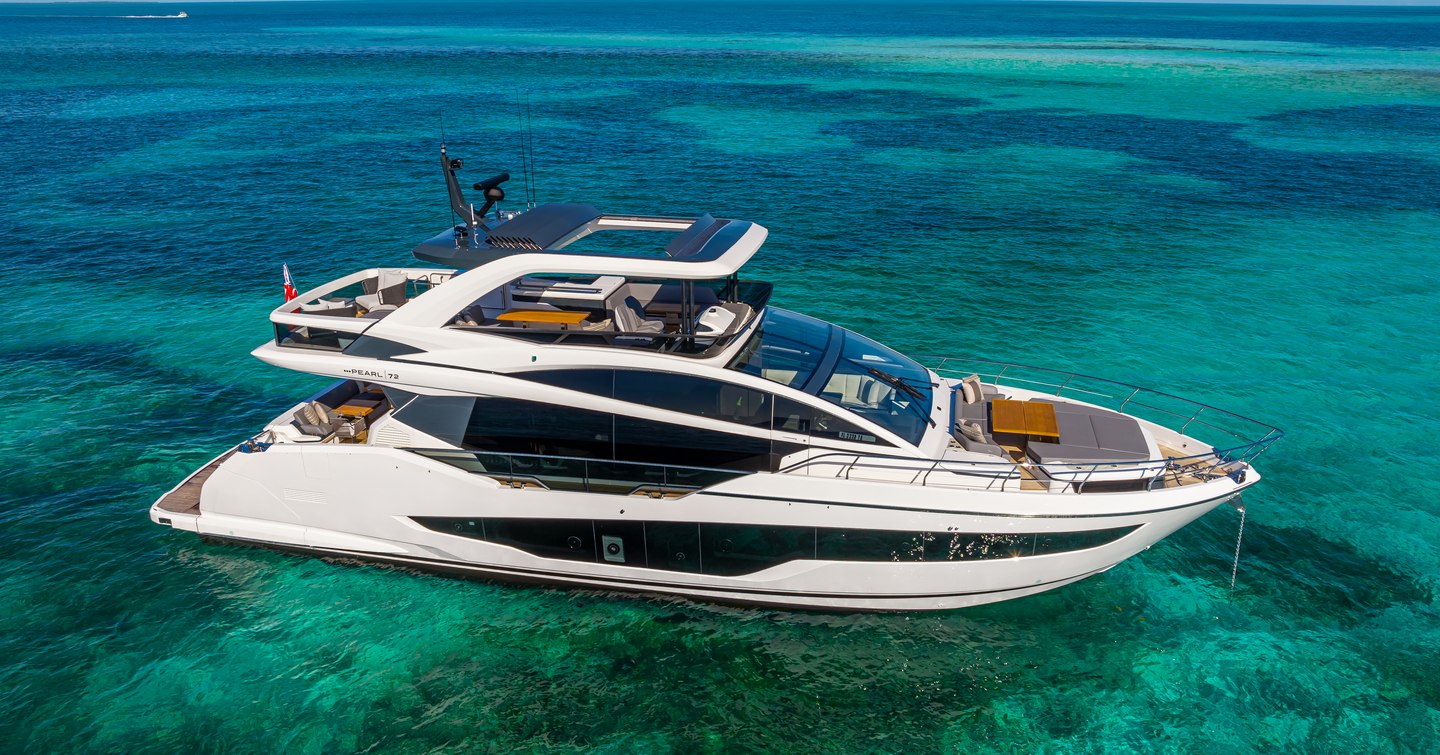
Our Options & Pick
Our heavily optioned test boat came in at GBP £3.73M ex VAT (at the time of publishing). What options you choose will depend on budget and how the boat is going to be used but there are a few that I think are with particular consideration. The MTU 1,600hp engines are a GBP £55,000 upgrade but their easy power and flexible cruising band make a big difference, especially on a boat loaded with toys and cruising gear. I wouldn't usually plump for the tilt/vane hard top but, even though it's nearly GBP £100,000, the fact that it opens fully really adds to its usefulness so it probably is the one to have.
The folding side platforms are GBP £40,000 but they're a useful addition if you like your water toys and will spend a lot of time at the waterline. The Modern interior decor, which uses lighter woods, is a no-cost option and you'll pay GBP £30,000 for either the darker wood Luxury interior or the signature Kelly Hoppen that you see in these photos. It won't be to all taste but for its individuality alone it's a tempting prospect and some will just fall for its anti-boat style.
Items like the passerelle (GBP £28,000) and air-con (GBP £42,000 for Med spec, GBP £50,000 for tropical) may come into the equation depending on where the boat will be berthed but if you plan to spend any real time on anchor the GBP £130,000 Seakeeper SK18 could be a game changer and it will have some effect during slow speed cruising, too.
Our Verdict
Pearl is well aware that it has to do things differently to tempt buyers away from the more mainstream brands and it embraces this challenge. The 72 is a clear product of this mentality and there is ambition all over this boat, from the tender garage to the thought that's gone into the deck spaces and, of course, the layout and decor of the interior. It never feels like things are being done for the sake of it, however, and the design decisions add so much to the way this boat comes together as a whole and, most importantly, improves life on board for those who own and live on board it. There are compromises here and there but considering what good value the 72 represents, these are easier to accept. This is all well and good but it's worthless if the boat doesn't perform on the water but that is not an issue that haunts the 72. It's a delight to drive at low and high speeds and a level performance that suits whatever speed you want to cruise at. Is this the best boat Pearl has ever made? It might well be.
Reasons to Buy
- Brilliant packaging
- Big tender garage
- Characterful interior
- Value for money
- Handling & performance
Things to Consider
- Engine room and crew space are a little cramped
- Subjective 'Indulgence' interior decor
- Sharp edges in the interior
Looking to own a Pearl 72? Use YachtBuyer’s Market Watch to compare all new and used Pearl 72 Boats for sale worldwide. You can also order a new Pearl 72, customized to your exact specifications, with options for engine choice and layout configuration. Alternatively, explore our global listings of new and used boats for sale and find your perfect boat today!
Rivals to Consider
This is one of the most competitive sectors so there is no shortage of talent for the Pearl 72 to come up against. Here is a selection of its closest rivals.
The Princess Y72 is one of the best boats the Plymouth-based shipyard builds. It looks great, has a brilliant balance of deck space and interior volume, is beautifully put together and nearly cracks 35 knots flat out. The Princess and Pearl share similar engine options and tank capacity so their performance is likely to be pretty similar. On board, there isn't a tender garage but it does have larger and more comfortable crew accommodation than the Pearl. The Y72's guest accommodation comprises two doubles and two twins, but the twin beds do have the option to slide together to create double beds when required. The design is safer than the Pearl's and it costs a bit more money but in this sector, it is the one to beat.
Rounding off the British rivals are the Sunseeker Manhattan 68 and Fairline Squadron 68, both of which are slightly smaller than the Pearl but would no doubt be in the conversation for anyone looking to buy a flybridge of this size. Neither boasts the space on the lower deck of the Pearl and they don't have tender garage options but the Fairline has a very flexible layout with the choice of three cabins and a day head, the same arrangement with a utility room or a four-cabin option. Interestingly, the Sunseeker, which runs on Volvo Penta IPS1350, has a lower deck galley option as well as the standard galley-up arrangement.
One boat that can certainly keep up with the Pearl in the style stakes is the Azimut 72. It isn't the latest generation of Azimut flybridge so it doesn't have the Alberto Mancini/Achille Salvagni design combination. It is a great-looking boat with a similar penchant to the Pearl for mirrored glass, though its deck spaces - especially the flybridge - aren't as expansive. It does, however, have both the amidships galley arrangement and three doubles and a twin on the lower deck like the Pearl. The cabin spaces aren't quite as roomy but then because there is no tender garage it does have a more spacious crew area. It shares the MAN V12 1,400hp engine option with the Pearl and will perform almost identically, though with a 1,000-litre greater fuel capacity its slow speed range will be superior.
Considering a new boat? Explore Pearl's entire current range to find the model that best suits your needs, and compare it with alternatives from competitors to ensure you make the perfect choice.
Specifications & Performance
- Builder Pearl Yachts
- Model Pearl 72
- Length Overall 72.146ft
- Beam 18.865ft
- Draft 5.577ft
- Hull GRP
- Cabins 4
- Berths 8
- Crew 2
- Cruising Speed
- Max Speed
- Fuel Capacity 1,123 Gallons
- Fresh Water Capacity 156 Gallons
- Engine Model 2x MTU 10V 2000 M96L
- Engine max range (speed type) 250 (nm)
Performance Data
Pearl 72 version 2022. *Data supplied by the manufacturer.
Test Engines Twin MTU 10V 2000 M96L
- RPM
- Knots
- Liters Per Hour
- Liters Per Mile
- Range (nm)
- Decibels
-
- ECO
- 1,000
- 10.3
- 70
- 7
- 575
- -
-
- 1,200
- 11.5
- 116
- 10
- 387
- -
-
- 1,400
- 12.9
- 180
- 14
- 280
- -
-
- 1,600
- 16.0
- 260
- 16
- 240
- -
-
- 1,800
- 21.0
- 325
- 16
- 252
- -
-
- CRUISE
- 2,000
- 25.0
- 395
- 16
- 247
- -
-
- 2,200
- 29.0
- 494
- 17
- 229
- -
-
- MAX
- 2,300
- 33.0
- 510
- 16
- 216
- -
Notes: Half load running data with 10% fuel in reserve
Interested in a Pearl 72?
NEW Build
Find your local dealer for a personalised, no-cost consultation
or just request
Brochures & Pricing
Used & In Stock
Looking for a ready-to-go Pearl 72 or pre-owned options? Explore all inventory of the Pearl 72 available worldwide
